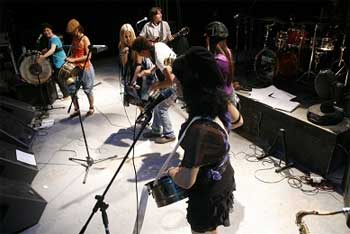Cuba’s Lindiana Murphy of “Mantra”
By Helson Hernandez

HAVANA TIMES, Sept 3 — Today we interview Lindiana Murphy, the director and vocalist with the band Mantra. Discussing its progression, she commented, “Many people sometimes don’t have the courage to face change; but believe me, after that change starts you may begin from zero but it’s worth thousands.”
HT: “Catapulteando” was the song that allowed people to get to know Lindiana and Mantra.
LINDIANA MURPHY: Well that was a song that arose without anyone intending it to, like almost everything. When we were making the arrangements we realized that it had a touch of Mantra, that’s to say a bit of mysticism, and the message that the song brings with it is pretty positive. In the first part the song tells the story of someone who’s frustrated, but for an ending we wanted something more upbeat, more encouraging. That’s why it concludes saying, “You have to live for the moment now.” In fact that has been one of the most consistent mantras that we’ve had.
HT: So we could summarize “Catapulteando” — the first great hit by Lindiana and Mantra — as a plea against frustration.
LM: Exactly. I might add that nor is it necessary to wait and watch the days go by and not do anything because of your frustration. That also has to do with my own experiences, with what I’ve lived through. I believe we all have stories like being in the wrong place and doing the wrong thing, at least until we realize that we can’t do that any longer and that we need to take another path. Many people sometimes don’t have the courage to face change; but believe me, after that change starts you may begin from zero but it’s worth thousands.
HT: And since you reiterate the word “mantra” so much, from your own interpretation can you clear up for us the meaning of “mantra,” which at the same time turns out to be the name of your group.
LM: Yes, mantra is kind of a sound that is connected with people who practice that Indian philosophy, which is what the name owes itself to. That’s precisely our principal mantra – just as the song expresses. It’s necessary to live life now; you have to experience it now. With that concept we connect with the public. It’s interesting, because during our last tour, even the Italians went nuts chanting the chorus.
HT: I understand that you were in sports before music.
LM: I began in basketball, at the PRE-EIDE sports school, which at that time was a springboard for a career in professional sports. This almost cost me because I came close to not being able to study music, because the kids who were in that sports school weren’t allowed to opt for studies in the arts.

Then in fifth grade I applied to go into music; and since those schools focusing on sports education were already starting to be eliminated, they let me enroll in a music program after I passed all the entrance exams, specifically to study choir directing. I finished that program after nine years of study.
HT: Was there was some important experience at the beginning of your musical training?
LM: Yes. By chance, when I was 15 in junior high school in Matanzas, there was a choir director who was my regular teacher. His name was Jose Antonio Mendez. He was well respected for being the only one with a doctorate specifically in choral singing. Anyway, he asked me to join his group of professional coral singers even though I was still a student.
I stayed with them until I was 20. It all proved to be a very important experience because I think I began singing thanks to him and all the things I learned over that period. I had a throaty contralto voice but I ended up singing as a soloist by adopting the frame of mind of a soprano, though I’m really a mezzo-soprano.

Of course after all this I also formed my own group of traditional music. That lasted for four years. Later I entered the world of jazz with the group Mestizaje. I also went to Moscow for a while with the renowned Cuban musicians Rojitas and Coco Freman. Still, my ultimate dream was my current project, Mantra. But without a doubt, out of all I’ve done, jazz helped me to find the direction that I truly wanted pursue.
HT: Your group incorporates instruments that are very distinct from what are commonly used in performing music in Cuba.
LM: Yes, in some songs there appear certain instruments that in a certain way are exotic. For example we include Udu drums, which are percussion instruments from Nigeria. We’ve also adopted Indian tablas, hand drums whose study takes eight years. Those are two rare and complicated to obtain kinds of drums, because they use very specific skins. Then too we use the Darbuka, which is from Turkey.
These are the three most unusual instruments through which Cubans identify the sound of Mantra, in addition to the violin, saxophone, electric guitar, bass, drums and piano, and me – as vocalist in this case. We plan to add other instruments, but we’re waiting for the next trip to be able to get them. Since they’re so folkloric it’s very difficult to come across them here, that’s the case with a wind instrument that we were trying to find.
HT: Evidently there’s an intention to have a certain aesthetic of the group, sounds that go beyond our immediate musical ones. Is there some reason for this interest?
LM: What’s happening with us is that we’re a generation that’s going through what many of today’s composers are also unconsciously experiencing. What I’m saying is that we could have all had past lives, because the first time I heard Indian music I was completely captivated, and not only Indian music; I believe that the folklore of all countries is fascinating.
On the other hand we live in a world that’s now globalized with such widespread flows of information. There used to only be cassettes, and even those were hard to get. But fortunately my generation has the privilege of being in the digital era, and undoubtedly that will always have an influence on creators.

This has had a big impact on me personally because I don’t have that limitation on creating. I’m not a person who limits themself to only what they studied in school, which would mean imposing certain boundaries. We use all those influences that identify us, what’s called “World Music,” and we then introduce it to our culture.
HT: You recently premiered a song on the popular television program Cuerda Viva that has become somewhat controversial.
LM: The song is called “La cabra” (The goat), and it’s really crazy because it’s a complete polka. It’s a way of laughing at ourselves and all the things that we’ve been through. I think the Russian cartoons left an important imprint on several generations of Cubans. By no means are we making fun of them, on the contrary, we’re making fun of ourselves, of the so many lunatics there are in our society, and a little bit at that Cuban insanity of mixing everything together – from the Russian to everything else that comes to us.
People identified closely with that song. We tell them not to get all worked up so as not to reach that point of madness. Take a bath with kimbombo (okra) so that everything slides. That’s why it’s a “kimbombo,” with a “k,” because it’s more psychological, not to eat like the quimbombó that all of us Cubans know.






linda camilihnj j2012